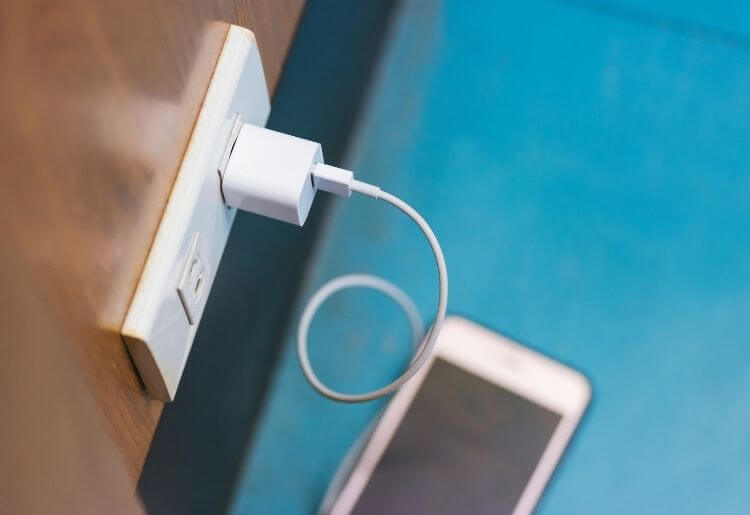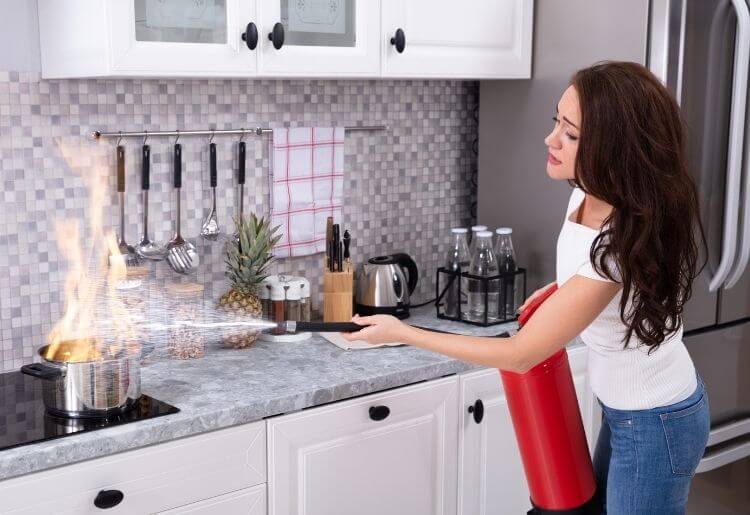Learning about fire hazards in the home is a good place to start. Since some domestic fires are caused by faulty appliances, we also recommend purchasing a home warranty policy, to help ensure your appliances are fixed when necessary. Homeowners insurance can provide you coverage for fire damage, but it’s best to try and avoid a domestic fire first.
According to the National Fire Protection Association, US fire departments respond to an estimated 346,000 home fires per year. How do you make sure your home doesn’t become one of the statistics? Read this guide to learn about the fire hazards in your home you didn’t know about.
1. Space Heaters
Space heaters can be a lifesaver during the cold winter months if you don’t have central heat in your home. However, while your space heater will keep you warm, it poses a hidden danger. Space heaters typically cause fires when they malfunction. This often happens when a space heater overheats because it was left on for too long or when someone is using an older model that doesn’t automatically shut off when the unit overheats.
According to the Consumer Product Safety Commission, space heaters cause over 1,000 fires in homes each year. To prevent fires, keep your space heater on the floor, at least three feet away from blankets, clothes, draperies, furniture, bedding, stuffed animals, mattresses, and other flammable products.
You should also keep electric space heaters away from water, to avoid electrical fires, and never leave your space heater running unattended.
2. Antiques Appliances
Antiques can help add a lot of character to your home. However, old wiring in antique appliances can present a safety hazard, as the wiring becomes dry and brittle over time, which could lead to a fire.
If you’re a fan of vintage light fixtures, it’s imperative to know how old the wiring in the light fixture is, whether or not the wiring has recently been replaced, and whether the wiring is from the United States or Europe.
Check for a UL (Underwriters Laboratories) label on the wiring to ensure that it’s safe to use. The UL is a global independent safety organization that checks lighting fixtures to ensure they’re safe.
Purchasing a home warranty policy from a company like Liberty Home Guard may also help protect some of your antique appliances.
3. Dryer Lint
Dryer fires result when filters, vents, or ducts become clogged. Usually, the clogging is a result of lint buildup, but it can also be caused by the accumulation of dirt, grass, or other materials.
This is why it’s so important to regularly clean the lint trap in your dryer. Clean the lint screen after each use, and also take some time to clean out the duct and vent. If you notice that your clothes aren’t properly drying after each cycle, the venting system may be obstructed. You should also have your dryer routinely inspected to check for improper fittings and leaks.
Investing in a home warranty policy that covers dryer fires is also a prudent decision.
4. Devices with Lithium-Ion Batteries
Lithium-ion batteries can be a fire hazard if you charge them incorrectly. Lithium-ion batteries are found in many house-hold items, and especially high-tech objects such as smartphones, tablets, laptops, game console controllers, digital cameras, and bluetooth headsets. They house a lot of power, so you should be very careful about how you handle them.
Before you plug in a device with a lithium-ion battery into an electrical outlet, make sure you’re charging the device on a hard surface. Leaving your device on a soft surface, such as a bed or a sofa, can cause heat to build up. You should also make sure there aren’t any sources of heat near your device when it’s charging (like a space heater or kitchen appliance) or any of the other fire hazards included on this list near your device when it’s charging.
Check that the cord you’re charging with is fully untangled before you begin charging. Cords that are kinked or coiled have the potential to overheat.
You also need to be very careful about how you handle the battery, as dropping a lithium-ion battery can cause the interior chemicals to emit excessive heat, which could potentially ignite.

5. Nail Polish and Nail Polish Remover
Nail polish and nail polish remover are major fire hazards in your home. Acetone is a key ingredient in both polish and remover, and it’s an extremely flammable liquid.
While nail polish formulas vary, most of them contain acetone or nitrocellulose, another extremely flammable chemical. When applying nail polish, be aware of any flammable materials and open flames nearby. Nail polish is most flammable when wet, so once your nail polish dries, the fire hazard is greatly reduced.
Nail polish remover often contains nearly 100% acetone, so make sure you store your nail polish remover in a cool, dry place. After using nail polish remover, make sure to wash your hands thoroughly.
One of the most common incidents with nail polish remover is for it to catch fire in a trash bin, especially if something hot is thrown in after it (like a used match). When throwing away a bottle or container of nail polish remover, be sure to squeeze or rinse out any excess liquid, to reduce the amount of flammable liquid that ends up in the garbage bin. Alternatively, dispose of it at your nearest hazardous waste facility.
6. Polished furniture
People typically use linseed oil to polish furniture and other wooden products. Linseed oil is a drying oil, which means it can quickly oxidize into a solid form during the drying process. During the process, linseed oil generates heat. This is the same chemical process that can cause a fire.
In some cases, the heat produced by linseed oil can ignite the rag or material being used to apply the polish, even with no other heat source. This is known as spontaneous combustion.
Fires can occur on linseed-oil-soaked rags that are left tightly balled up after use. Therefore, you should always rinse, unravel, and dry linseed-oil-soaked rags after using before you dispose of them or put them in storage. Store dried rags in a container with a tight-fitting lid away from other flammable materials.
7. Hand Sanitizer
According to the CDC, hand sanitizers should contain at least 60% alcohol if they’re being used in hand washing or activities to stop the spread of viruses. Most hand sanitizers on the market contain 60 to 80% ethanol or isopropanol, which are both types of alcohol.
While small quantities of hand sanitizer don’t typically pose a fire risk, it’s still important to be careful when using and storing sanitizer to minimize any risks. Always make sure the sanitizer has completely dried on your hands before touching any metal surfaces in your home.
Many people use hand sanitizer before cooking. If you do so, be careful when using a stove or other heating appliances in your kitchen. Wait until the sanitizer has dried completely before cooking, and be sure to apply it away from these kinds of appliances.
8. Potential Cooking Fire
While grease is an essential component when cooking many delicious dishes, it’s also a highly flammable material.
Here are some tips to keep in mind to help you prevent grease fires when cooking.
- Heat oil slowly and add food slowly to prevent splatter
- Always have a metal pot lid nearby in case of a pot fire. The fastest way to extinguish a fire in a cooking pot is to deprive it of oxygen by putting on the lid.
- Always keep a fire extinguisher nearby when cooking
- Keep flammable items, such as oven mitts, rags, and wooden spoons, away from your stovetop
- Use a thermometer to monitor the grease temperature, and always keep it at the recommended temperature
- Never leave pots or pans unattended when cooking, as it only takes about 30 seconds for smoke to turn into fire
- Remove as much moisture as possible from food before cooking in grease, and never cook frozen food in grease
Investing in a home warranty from a company like Choice can also help cover the costs of appliances damaged in fires.
9. Cleaning Products with Orange Oil
Many people are shocked to find out that one of America’s favorite fruits is also a fire hazard. Orange peels have tiny pockets for storing oil. Over 90% of this oil contains a chemical called limonene, which is a highly flammable liquid.
Orange oil, which is made from the skin of oranges, can sometimes be found in everyday household cleaning products. It’s especially common in degreasing agents and furniture polishers or shiners. It’s also common to find orange oil in all-purpose cleaning sprays that contain baking soda and water.
To reduce the risk of a fire, never spray products containing orange oil near an open flame or near fire sources like stovetops. Also, make sure to store your oranges a good distance from your stovetop, and throw the orange peels straight into the garbage after use.
10. Sugar and Other Baking Ingredients
Sugar and other common cooking and baking ingredients can pose fire safety hazards. Sugar is a carbohydrate, and when the sugar molecules heat up, they can ignite. This is also true for flour and other spices like chili powder, cinnamon, and garlic powder.
However, sugar and spice “explosions” only pose a serious risk if the ingredients are near other combustible materials. Therefore, make sure to store sugar and other powdered ingredients in tightly-sealed containers away from open flames and heat sources like stoves.
Also, avoid using baking powder or flour as substitutes for baking soda or salt, as they’re lighter weight and more combustible.
Conclusion
There are many everyday household items that can pose fire hazards to your home. Knowing how to properly store and care for these items is crucial in preventing home fires and fire deaths.
Make sure family members are aware of these items as well so everyone practices the proper fire prevention procedures and stay safe.
